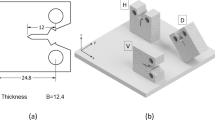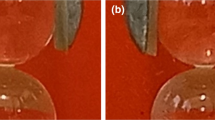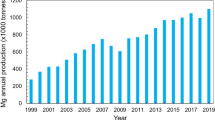Abstract
The flexural strength of gypsum is reported for freestanding single crystals in three-point bending carried with a nanoindenter. The elastic modulus, splitting tensile strength, and fracture toughness of monolithic gypsum consisting of interlocking needle-like microcrystals are also reported as functions of porosity and accelerator addition. This study shows that geometric configurations, in addition to porosity, affect the mechanical properties of gypsum. The properties are improved by 50–100% when the crystal network changes from needle aggregates to one made up of homogeneous randomly oriented single crystals. An Ashby geometric model for open-cell foams is adopted to link the properties of the individual crystals and the bulk properties. The lower and upper bounds of the measured elastic modulus are in accordance with bending-dominated behavior and stretch-dominated behavior predicted by the model, respectively. However, the strength of gypsum is much lower than values predicted by the model, which is based failure on fracture of individual crystals, suggesting that the strength of monolithic gypsum may be instead controlled by the failure of weak intercrystalline contacts.











Similar content being viewed by others
References
Gibson LJ, Ashby MF (1997) Cellular solids, structure and properties, 2nd edn. Cambridge University Press, Cambridge, UK
Soroka I, Sereda PJ (1968) J Am Ceram Soc 51(6):337
Vekinis G, Ashby MF, Beaumont PWR (1993) J Mater Sci 28:3221. doi:10.1007/BF00354239
Sattler H (1997) ZKG Int 50(1):54
Meille S, Garboczi EJ (2001) Modell Simul Mater Sci Eng 9:371
Jeulin D, Monnaie P, Peronnet F (2001) Cem Concr Compos 23:299
Singh NB, Middendorf B (2007) Prog Cryst Growth Char Mater 53(1):57
Amathieu L, Boistelle R (1986) J Cryst Growth 79(1–3):169
Osterwalder N, Loher S, Grass RN, Brunner TJ, Limbach LK, Halim SC, Stark WJ (2007) J Nanopart Res 9:275
Constantinides G, Ulm F-J (2004) Cem Concr Res 34:67
Kaul VS, Faber KT (2008) Scr Mater 58:886
Uchic MD, Dimiduk DM, Florando JN, Nix WD (2004) Science 305(5686):986
Schuster BE, Wei Q, Zhang H, Ramesh KT (2006) Appl Phys Lett 88(10):103112
Lee D, Wei XD, Zhao M, Chen X, Jun SC, Hone J, Kysar JW (2007) Modell Simul Mater Sci Eng 15:S181
Chen X, Xu Z, Li X, Shaibat MA, Ishii Y, Ruoff RS (2007) Carbon 45(2):416
Satava V (1996) Ceramics-Silikaty 40(2):72
Oliver WC GM, Pharr GM (2004) J Mater Res 19:3
ASTM Standard C769-98 (2005) Standard test method for sonic velocity in manufactured carbon and graphite materials for use in obtaining an approximate Young’s modulus
ASTM Standard C1419-99a (2007) Standard test method for sonic velocity in refractory materials at room temperature and its use in obtaining an approximate Young’s modulus
ASTM Standard E494-05 (2005) Standard practice for measuring ultrasonic velocity in materials
Miller DP, Moslemi AA (1991) Wood Fiber Sci 23(4):472
Jonsén P, Häggblad H-Å, Sommer K (2006) Tensile strength and fracture energy of pressed metal powder by diametral compression test. Doctoral thesis, D1-D18
ASTM C 1421-01b (2001) Standard test methods for determination of fracture toughness of advanced ceramics at ambient temperature
Petrovic JJ, Milewski JV, Rohr DL, Gac FD (1985) J Mater Sci 20:1167. doi:10.1007/BF01026310
Underwood EE (1970) Quantitative stereology. Addison-Wesley, Publishing Co., Inc., Reading, MA
Ashby MF (2006) Phil Trans R Soc A 364:15
Tuncer E, Wegener M (2004) Mater Lett 58:2815
Broz ME, Cook RF, Whitney DL (2006) Am Mineral 91:135
Maalej M, Li VC (1994) J Mater Civ Eng 6(4):513
Ohnishi S, Stewart AM (2002) Langmuir 18:6140
Follner S, Wolter A, Helming K, Silber C, Bartels H, Follner H (2003) Cryst Res Technol 37(2–3):207
Coquard P, Boistelle R (1994) Int J Rock Mech Min Sci Geomech Ahslr 31(5):517
Chappuis J (1999) Colloids Surf A Physicochem Eng Asp 156:223
Israelachvili JN, Pashley RM (1983) Nature 17:249
Acknowledgements
Support for this study was provided by USG Corporation. The nanoindentation work was performed at the NIFTI facilities of NUANCE Center at Northwestern University. The SEM work was performed at the EPIC facilities of NUANCE Center. NUANCE Center is supported by NSF-NSEC, NSF-MRSEC, Keck Foundation, the State of Illinois, and Northwestern University.
Author information
Authors and Affiliations
Corresponding author
Rights and permissions
About this article
Cite this article
Chen, Z., Sucech, S. & Faber, K.T. A hierarchical study of the mechanical properties of gypsum. J Mater Sci 45, 4444–4453 (2010). https://doi.org/10.1007/s10853-010-4527-z
Received:
Accepted:
Published:
Issue Date:
DOI: https://doi.org/10.1007/s10853-010-4527-z




